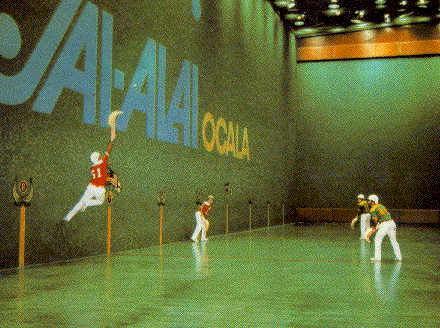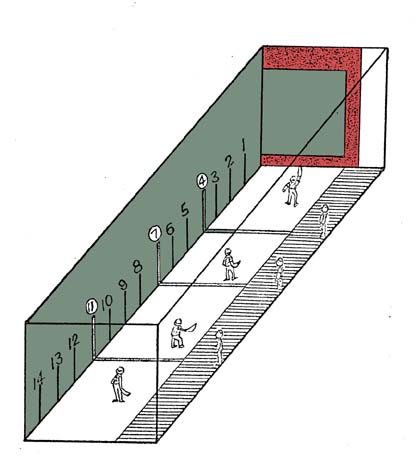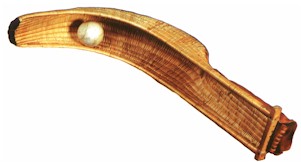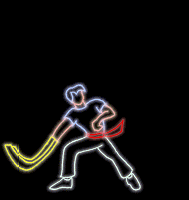
TARGET 070307
Ballet with bullets
The game of Jai Alai

Jai-alai is the fastest game in the world. Think of it as an exotic version of handball, played on an enormous 3-walled court by two teams at a time (each with one or two men). The object of the game is simply for the teams to alternate in catching and throwing the ball against the front wall until one player manages to throw the ball with such speed and spin that his opponent(s) cannot catch it or return it properly.
What makes jai-alai so exciting is that the players catch and throw the ball with a basket-like device which is strapped to their right hand. This basket (called a cesta) resembles the beak of a seagull, but is actually a catapult that enables the players to sling the rock-hard ball (called a pelota) against a foot-thick wall of solid granite at speeds reaching almost 250 feet per second.
Because of the blurring speed of the ball and the acrobatic skills of the players, jai-alai has been described as a blend of "Ballet with Bullets" (The above was excerpted from probably the best website for an introduction to the game: Tiger Chalk Talk Home page
It is believed that Jai-alai began in the Basque region of Spain and France more than three centuries ago. The first permanent Jai-alai fronton (ball court) in the United States was built in Miami in 1926. A "fronton" is the court on which Jai Alai is played. It is normally indoors, with three very thick walls, and one protective glass or wire side wall through which spectators can safely watch the without fear of being hit by a stray ball or flying player.
From your seat in the audience, the cancha looks quite large. As you sit in the audience, the players' front wall or "frontis" is to your right; the players' rear wall or "rebote" is to your left. The players' side wall or "lateral" is on the other side of the court from you. The court's length (from your right to your left) is generally 175 to 180 feet long, but can be up to 225 feet. That wall is usually made of granite. The walls are generally 40 to 50 feet high. The two other walls and the floor (which will be hit by the ball) are normally of gunite, a reinforced and very dense concrete. The wall through which you watch the game is usually a very strong wire screen. Between the hard surfaced court and the screen is an out-of-bounds area (the contracancha) with a wooden floor 10 to 15 feet wide, running the length of the court. The total distance from the players' side wall to the screen is 50 to 55 feet.
Since the court is always watched from the players' right side, this game is the only game in the world which does forbids left-handed people to play.

The spectators' view of the court.
As you can see in the top picture, a player wears a strange looking "glove" on their right hand. This "glove" is called the "Cesta". It is, in effect, a wicker basket, tailor-made to each player's specifications. Frontcourt players usually play with smaller cestas designed for speed and quick delivery of the pelota. Backcourt cestas are larger and are designed for throwing from longer distances. The length, curve and ribbing of the cesta give the pelota extraordinary speed and spin.

The hand is inserted flat into a leather glove sewn to the outside area of the cesta. A long tape (cinta) is wound around the glove to prevent the secure the cesta to the player's hand. Cestas cost over $200 each and only last a few weeks because of the tremendous abuse they suffer during a game.
The Ball, or "Pelota" is the most lethal ball of any sport. It is about 3/4 the size of a baseball, harder than a golf ball, and has been clocked at speeds of up to 188 m.p.h. The Guinness Book of World Records calls it "the world's fastest projectile."

The pelota is constructed of hand-woven virgin de Para rubber from Brazil with a layer of nylon thread and two coats of specially hardened goat skin. A pelota costs over $100 and after 20 minutes of play, the outside layer of goat skin is cracked and torn beyond use. Several dozen may be used during one 12-game program. While it can be re-covered and used again, it must be replaced by another during play. The pelota is hand-made. It is 2 inches in diameter and weighs approximately 4.5 ounces. Therefore, it is somewhat lighter than a baseball and only about three-fourths its size. However, it is livelier than a golf ball, due to its hard rubber core.
The players wear rubber-soled shoes, white trousers with a red sash (faja), and a colored jersey designating the player's post position. They may have different numbers on the front and back, because the number on the front of the jersey designates the post-position. The number on the back is the player's roster number.
Safety helmets were introduced in 1968, after a series of severe injuries.
For a tremendously good explanation of the game, its rules, how to bet on the games, and just about every other aspect of the game, go to the Tiger Chalk Talk Home page